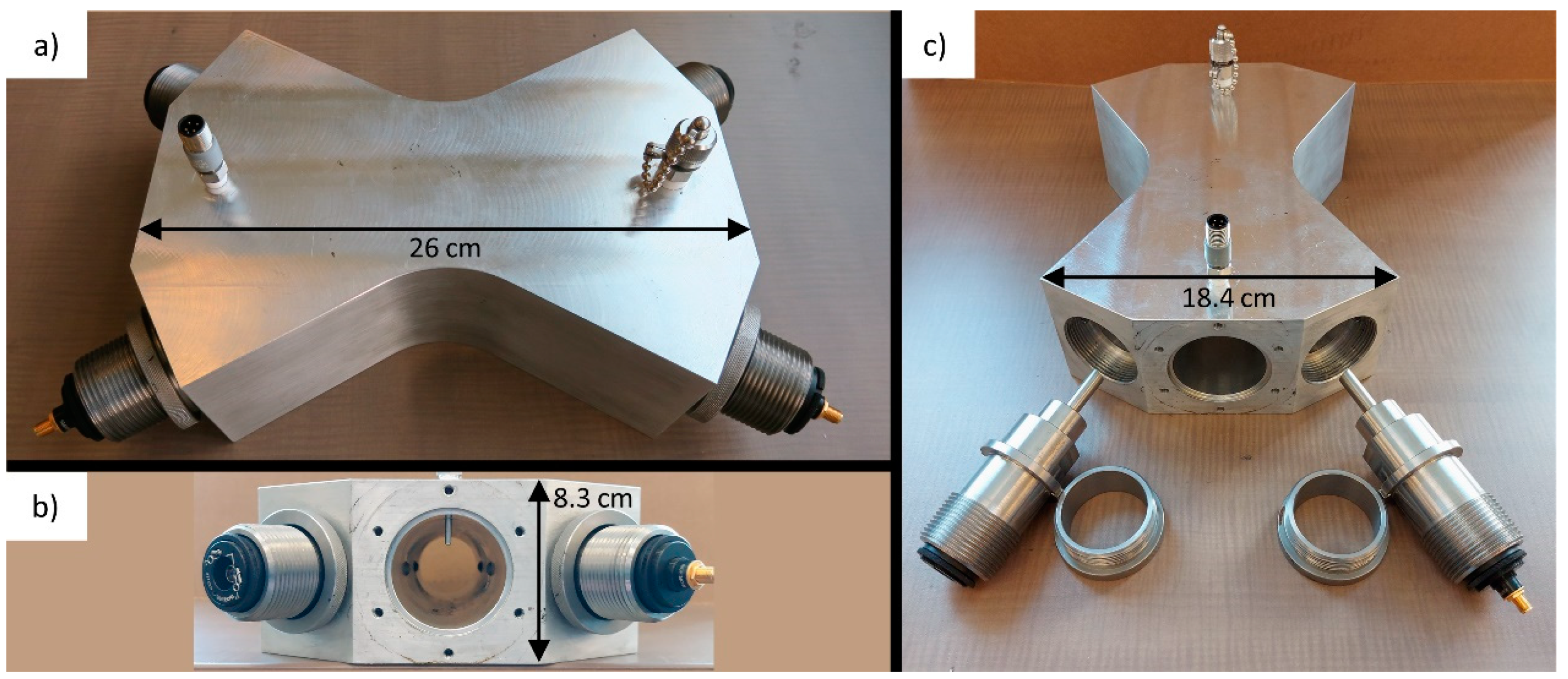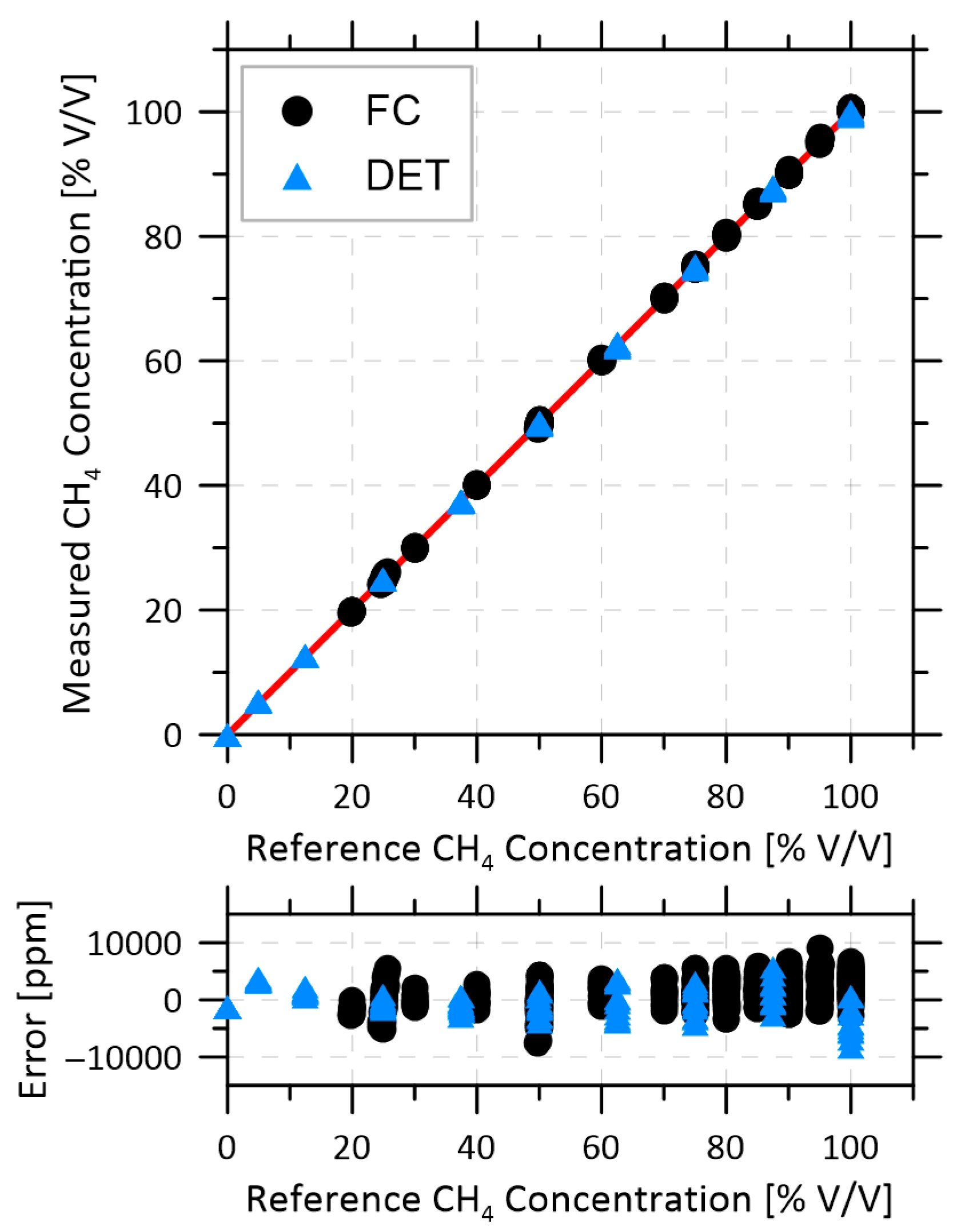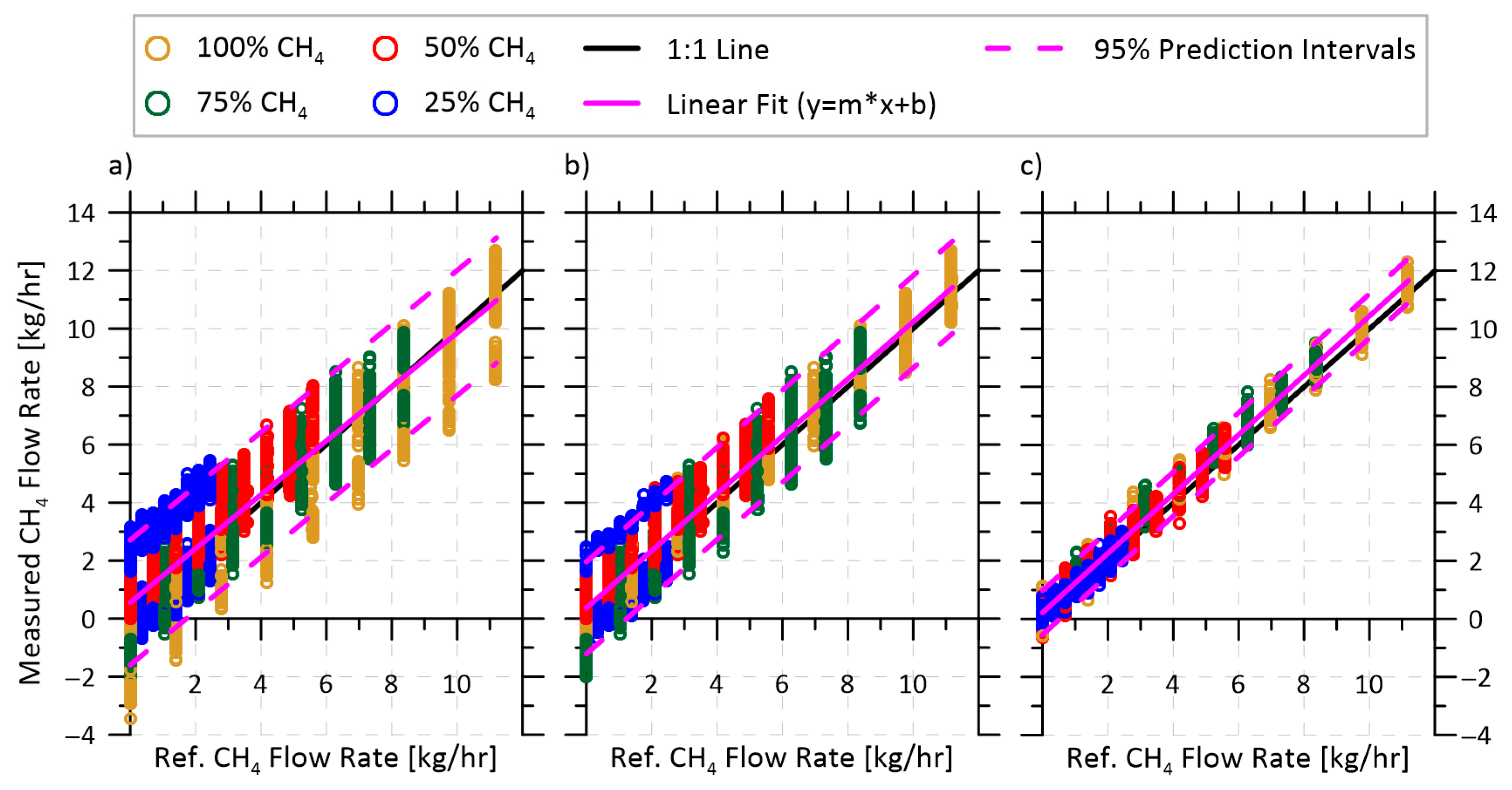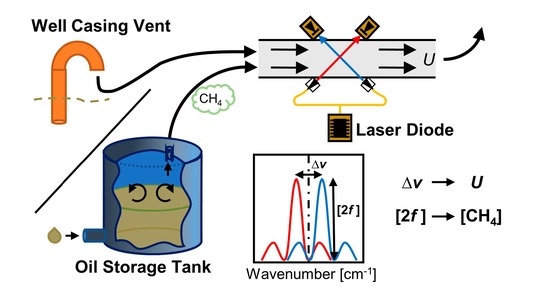A Wavelength Modulation Spectroscopy-Based Methane Flux Sensor for Quantification of Venting Sources at Oil and Gas Sites
Abstract
:1. Introduction
2. Materials and Methods
2.1. Wavelength Modulation Spectroscopy
2.2. Velocity Methodology
2.3. Sensor Description
3. Results
3.1. Methane Volume Fraction
3.2. Flow Velocity
3.3. Methane Mass Flow Rate Accuracy in Different Field Measurement Scenarios
4. Conclusions
Author Contributions
Funding
Acknowledgments
Conflicts of Interest
References
- Lyon, D.R.; Alvarez, R.A.; Zavala-Araiza, D.; Brandt, A.R.; Jackson, R.B.; Hamburg, S.P. Aerial Surveys of Elevated Hydrocarbon Emissions from Oil and Gas Production Sites. Environ. Sci. Technol. 2016, 50, 4877–4886. [Google Scholar] [CrossRef]
- Johnson, M.R.; Tyner, D.R.; Conley, S.A.; Schwietzke, S.; Zavala-Araiza, D. Comparisons of Airborne Measurements and Inventory Estimates of Methane Emissions in the Alberta Upstream Oil and Gas Sector. Environ. Sci. Technol. 2017, 51, 13008–13017. [Google Scholar] [CrossRef] [PubMed]
- Roscioli, J.R.; Herndon, S.C.; Yacovitch, T.I.; Knighton, W.B.; Zavala-Araiza, D.; Johnson, M.R.; Tyner, D.R. Characterization of Methane Emissions from Five Cold Heavy Oil Production with Sands (CHOPS) Facilities. J. Air Waste Manag. Assoc. 2018, 68, 671–684. [Google Scholar] [CrossRef] [PubMed]
- Tyner, D.R.; Johnson, M.R. Where the Methane Is—Insights from Novel Airborne LiDAR Measurements Combined with Ground Survey Data. Environ. Sci. Technol. 2021, 55, 9773–9783. [Google Scholar] [CrossRef] [PubMed]
- Ravikumar, A.P.; Roda-Stuart, D.; Liu, R.; Bradley, A.; Bergerson, J.; Nie, Y.; Zhang, S.; Bi, X.; Brandt, A.R. Repeated Leak Detection and Repair Surveys Reduce Methane Emissions over Scale of Years. Environ. Res. Lett. 2020, 15, 034029. [Google Scholar] [CrossRef]
- Peachey, B. Conventional Heavy Oil Vent Quantification Standards; New Paradigm Engineering Ltd.: Edmonton, Alberta, 2004. [Google Scholar]
- Measures, R.M. Selective Excitation Spectroscopy and Some Possible Applications. J. Appl. Phys. 1968, 39, 5232. [Google Scholar] [CrossRef]
- Chang, A.Y.; Dirosa, M.D.; Davidson, D.F.; Hanson, R.K. Rapid Tuning Cw Laser Technique for Measurements of Gas Velocity, Temperature, Pressure, Density, and Mass Flux Using NO. Appl. Opt. 1991, 30, 3011–3022. [Google Scholar] [CrossRef] [PubMed]
- Philippe, L.C.; Hanson, R.K. Laser-Absorption Mass Flux Sensor for High-Speed Airflows. Opt. Lett. 1991, 16, 2002–2004. [Google Scholar] [CrossRef]
- Arroyo, M.P.; Langlois, S.; Hanson, R.K. Diode-Laser Absorption Technique for Simultaneous Measurements of Multiple Gasdynamic Parameters in High-Speed Flows Containing Water Vapor. Appl. Opt. 1994, 33, 3296–3307. [Google Scholar] [CrossRef]
- Upschulte, B.; Miller, M.; Allen, M.G.; Jackson, K.; Gruber, M.; Mathur, T. Continuous Water Vapor Mass Flux and Temperature Measurements in a Model Scramjet Combustor Using a Diode Laser Sensor. In Proceedings of the 37th AIAA Aerospace Sciences Meeting & Exhibit, Reno, NV, USA, 11–14 January 1999. [Google Scholar]
- Schultz, I.A.; Goldenstein, C.S.; Jeffries, J.B.; Hanson, R.K.; Rockwell, R.D.; Goyne, C.P. Spatially Resolved Water Measurements in a Scramjet Combustor Using Diode Laser Absorption. J. Propuls. Power 2014, 30, 1551–1558. [Google Scholar] [CrossRef]
- Strand, C.L.; Hanson, R.K. Quantification of Supersonic Impulse Flow Conditions via High-Bandwidth Wavelength Modulation Absorption Spectroscopy. AIAA J. 2015, 53, 2978–2987. [Google Scholar] [CrossRef]
- Chen, S.J.; Paige, M.E.; Silver, J.A.; Williams, S.; Barhorst, T. Laser-Based Mass Flow Rate Sensor Onboard HIFiRE Flight 1. In Proceedings of the 45th AIAA/ASME/SAE/ASEE Joint Propulsion Conference & Exhibit, Denver, CO, USA, 2–5 August 2009. [Google Scholar] [CrossRef]
- Barhorst, T.; Williams, S.; Chen, S.J.; Paige, M.E.; Silver, J.A.; Sappey, A.; McCormick, P.; Masterson, P.; Zhao, Q.; Sutherland, L.; et al. Development of an in Flight Non-Intrusive Mass Capture System. In Proceedings of the 45th AIAA/ASME/SAE/ASEE Joint Propulsion Conference & Exhibit, Denver, CO, USA, 2–5 August 2009. [Google Scholar] [CrossRef]
- Brown, M.S.; Barhorst, T.F. Post-Flight Analysis of the Diode-Laser-Based Mass Capture Experiment Onboard HIFiRE Flight 1. In Proceedings of the 17th AIAA International Space Planes and Hypersonic Systems and Technologies Conference, San Francisco, CA, USA, 11–14 April 2011. [Google Scholar] [CrossRef]
- Lyle, K.H.; Jeffries, J.B.; Hanson, R.K. Diode-Laser Sensor for Air-Mass Flux 1: Design and Wind Tunnel Validation. AIAA J. 2007, 45, 2204–2212. [Google Scholar] [CrossRef]
- Lyle, K.H.; Jeffries, J.B.; Hanson, R.K.; Winter, M. Diode-Laser Sensor for Air-Mass Flux 2: Non-Uniform Flow Modeling and Aeroengine Tests. AIAA J. 2007, 45, 2213–2223. [Google Scholar] [CrossRef]
- Chang, L.S.; Jeffries, J.B.; Hanson, R.K. Mass Flux Sensing via Tunable Diode Laser Absorption of Water Vapor. AIAA J. 2010, 48, 2687–2693. [Google Scholar] [CrossRef]
- Kurtz, J.; Wittig, S.; O’Byrne, S. Applicability of a Counterpropagating Laser Airspeed Sensor to Aircraft Flight Regimes. J. Aircr. 2016, 53, 439–450. [Google Scholar] [CrossRef]
- Hecht, E. Optics, 4th ed.; Addison Wesley: Boston, MA, USA, 2002. [Google Scholar]
- Zolot, A.M.; Giorgetta, F.R.; Baumann, E.; Swann, W.C.; Coddington, I.; Newbury, N.R. Broad-Band Frequency References in the near-Infrared: Accurate Dual Comb Spectroscopy of Methane and Acetylene. J. Quant. Spectrosc. Radiat. Transf. 2013, 118, 26–39. [Google Scholar] [CrossRef]
- Festa-Bianchet, S.A.; Schoonbaert, S.B.; Johnson, M.R. Investigating Storage Tank Venting Losses: A Spectroscopic Approach. In Proceedings of the Air & Waste Management Association (AWMA) 108th Annual Conference, Raleigh, NC, USA, 22–25 June 2015; (Paper #526). p. 4. [Google Scholar]
- Chan, K.; Ito, H.; Inaba, H.; Furuya, T. 10 Km-Long Fibre-Optic Remote Sensing of CH4 Gas by near Infrared Absorption. Appl. Phys. B 1985, 38, 11–15. [Google Scholar] [CrossRef]
- Stewart, G.; Johnstone, W.; Thursby, G.; Culshaw, B. Near Infrared Spectroscopy for Fibre Based Gas Detection. In Proceedings of the Photonics in the Transportation Industry: Auto to Aerospace III, Orlando, FL, USA, 5–9 April 2010; Volume 7675. [Google Scholar] [CrossRef] [Green Version]
- Shemshad, J.; Aminossadati, S.M.; Kizil, M.S. A Review of Developments in near Infrared Methane Detection Based on Tunable Diode Laser. Sens. Actuators B Chem. 2012, 171–172, 77–92. [Google Scholar] [CrossRef]
- Reid, J.; Labrie, D. Second-Harmonic Detection with Tunable Diode Lasers—Comparison of Experiment and Theory. Appl. Phys. 1981, 210, 203–210. [Google Scholar] [CrossRef]
- Arndt, R. Analytical Line Shapes for Lorentzian Signals Broadened by Modulation. J. Appl. Phys. 1965, 36, 2522. [Google Scholar] [CrossRef]
- Goldstein, N.; Adler-Golden, S.; Lee, J.; Bien, F. Measurement of Molecular Concentrations and Line Parameters Using Line-Locked Second Harmonic Spectroscopy with an AlGaAs Diode Laser. Appl. Opt. 1992, 31, 3409. [Google Scholar] [CrossRef] [PubMed]
- Supplee, J.M.; Whittaker, E.A.; Lenth, W. Theoretical Description of Frequency Modulation and Wavelength Modulation Spectroscopy. Appl. Opt. 1994, 33, 6294. [Google Scholar] [CrossRef] [PubMed]
- Kluczynski, P.; Axner, O. Theoretical Description Based on Fourier Analysis of Wavelength-Modulation Spectrometry in Terms of Analytical and Background Signals. Appl. Opt. 1999, 38, 5803. [Google Scholar] [CrossRef] [PubMed]
- Schilt, S.; Thévenaz, L.; Robert, P. Wavelength Modulation Spectroscopy: Combined Frequency and Intensity Laser Modulation. Appl. Opt 2003, 42, 6728–6738. [Google Scholar] [CrossRef] [PubMed]
- Rieker, G.B.; Li, H.; Liu, X.; Jeffries, J.B.; Hanson, R.K.; Allen, M.G.; Wehe, S.D.; Mulhall, P.A.; Kindle, H.S. A Diode Laser Sensor for Rapid, Sensitive Measurements of Gas Temperature and Water Vapour Concentration at High Temperatures and Pressures. Meas. Sci. Technol. 2007, 18, 1195–1204. [Google Scholar] [CrossRef]
- Rothman, L.S.; Gordon, I.E.; Babikov, Y.; Barbe, A.; Chris Benner, D.; Bernath, P.F.; Birk, M.; Bizzocchi, L.; Boudon, V.; Brown, L.R.; et al. The HITRAN2012 Molecular Spectroscopic Database. J. Quant. Spectrosc. Radiat. Transf. 2013, 130, 4–50. [Google Scholar] [CrossRef] [Green Version]
- Liu, J.T.C.; Jeffries, J.B.; Hanson, R.K. Wavelength Modulation Absorption Spectroscopy with 2 f Detection Using Multiplexed Diode Lasers for Rapid Temperature Measurements in Gaseous Flows. Appl. Phys. B Lasers Opt. 2004, 78, 503–511. [Google Scholar] [CrossRef]
- Rieker, G.B.; Jeffries, J.B.; Hanson, R.K. Calibration-Free Wavelength-Modulation Spectroscopy for Measurements of Gas Temperature and Concentration in Harsh Environments. Appl. Opt. 2009, 48, 5546–5560. [Google Scholar] [CrossRef]
- Salazar, D.V.; Goldenstein, C.S.; Jeffries, J.B.; Seiser, R.; Cattolica, R.J.; Hanson, R.K. Design and Implementation of a Laser-Based Absorption Spectroscopy Sensor for in Situ Monitoring of Biomass Gasification. Meas. Sci. Technol. 2017, 28, 125501. [Google Scholar] [CrossRef]
- Li, H.; Rieker, G.B.; Liu, X.; Jeffries, J.B.; Hanson, R.K. Extension of Wavelength-Modulation Spectroscopy to Large Modulation Depth for Diode Laser Absorption Measurements in High-Pressure Gases. Appl. Opt. 2006, 45, 1052. [Google Scholar] [CrossRef]
- Miller, M.F.; Kessler, W.J.; Allen, M.G. Diode Laser-Based Air Mass Flux Sensor for Subsonic Aeropropulsion Inlets. Appl. Opt. 1996, 35, 4905–4912. [Google Scholar] [CrossRef] [PubMed]
- Axner, O.; Gustafsson, J.; Schmidt, F.M.; Omenetto, N.; Winefordner, J.D. A Discussion about the Significance of Absorbance and Sample Optical Thickness in Conventional Absorption Spectrometry and Wavelength-Modulated Laser Absorption Spectrometry. Spectrochim. Acta Part B At. Spectrosc. 2003, 58, 1997–2014. [Google Scholar] [CrossRef]
- Norooz Oliaee, J.; Sabourin, N.A.; Festa-Bianchet, S.A.; Gupta, J.A.; Johnson, M.R.; Thomson, K.A.; Smallwood, G.J.; Lobo, P. Development of a Sub-Ppb Resolution Methane Sensor Using a GaSb-Based DFB Diode Laser near 3270 Nm for Fugitive Emission Measurement. ACS Sens. 2022, 7, 564–572. [Google Scholar] [CrossRef] [PubMed]
- Baudrand, J.; Walker, G.A.H. Modal Noise in High-Resolution, Fiber-fed Spectra: A Study and Simple Cure. Publ. Astron. Soc. Pacific 2001, 113, 851–858. [Google Scholar] [CrossRef]
- Corbett, J.C.W.; Allington-Smith, J. Fibre Modal Noise Issues in Astronomical Spectrophotometry. In Proceedings of the Proceedings Ground-based and Airborne Instrumentation for Astronomy, Orlando, FL, USA, 24–31 May 2006; Volume 6269. [Google Scholar] [CrossRef]
- Werle, P.; Mazzinghi, P.; D’Amato, F.; De Rosa, M.; Maurer, K.; Slemr, F. Signal Processing and Calibration Procedures for in Situ Diode-Laser Absorption Spectroscopy. Spectrochim. Acta. A Mol. Biomol. Spectrosc. 2004, 60, 1685–1705. [Google Scholar] [CrossRef]








| Paper | Application | Gas | Absorption Range | Flow Range [m/s] | Best Performance 1 |
|---|---|---|---|---|---|
| Lyle et al. 2007a [17] | Wind Tunnel | O2 | Constant, 2.8% | 0–23 | ±0.25 m/s, SD = 0.22 m/s |
| Lyle et al. 2007b [18] | Turbine Inlet | O2 | Constant, 3.5% | 25–175 | SD = 5.4 m/s |
| Chang 2010 [19] | Wind Tunnel | H2O | Constant, 89% | 2.5–18 | ±0.5 m/s |
| Kurtz et al. 2016 [20] | Flight Speed Sensor | O2 | 1–2% | 5–380 | ~±26 m/s |
| Current Work | Methane Venting | CH4 | 0–45% | 0–4 | ±0.16 m/s, SD = 0.07 m/s |
Publisher’s Note: MDPI stays neutral with regard to jurisdictional claims in published maps and institutional affiliations. |
© 2022 by the authors. Licensee MDPI, Basel, Switzerland. This article is an open access article distributed under the terms and conditions of the Creative Commons Attribution (CC BY) license (https://creativecommons.org/licenses/by/4.0/).
Share and Cite
Festa-Bianchet, S.A.; Seymour, S.P.; Tyner, D.R.; Johnson, M.R. A Wavelength Modulation Spectroscopy-Based Methane Flux Sensor for Quantification of Venting Sources at Oil and Gas Sites. Sensors 2022, 22, 4175. https://doi.org/10.3390/s22114175
Festa-Bianchet SA, Seymour SP, Tyner DR, Johnson MR. A Wavelength Modulation Spectroscopy-Based Methane Flux Sensor for Quantification of Venting Sources at Oil and Gas Sites. Sensors. 2022; 22(11):4175. https://doi.org/10.3390/s22114175
Chicago/Turabian StyleFesta-Bianchet, Simon A., Scott P. Seymour, David R. Tyner, and Matthew R. Johnson. 2022. "A Wavelength Modulation Spectroscopy-Based Methane Flux Sensor for Quantification of Venting Sources at Oil and Gas Sites" Sensors 22, no. 11: 4175. https://doi.org/10.3390/s22114175







